
The Vision Council (TVC) has released its Consumer inSights Q3 2025 report, detailing U.S. consumer behavior and spending related to vision correction, managed vision care, eye exams, and eyewear. Based on a nationally representative survey of 12,097 adults conducted in the third quarter of 2025, the findings indicate that vision care utilization and purchasing patterns remained steady, with strong engagement in routine eye exams and in-person eyewear purchases.
According to the report, most adults with managed vision care continued to use their benefits at rates similar to previous quarters. Independent optical practices accounted for more than half of recent exams and eyewear purchases, while corporate and online retailers maintained significant participation, particularly among younger consumers and contact lens buyers. The data also suggest increased price sensitivity, as many respondents reported keeping out-of-pocket spending for glasses and sunglasses below $100 while maintaining overall satisfaction with their purchases.
Additional findings show that more than 80% of adults use some form of vision correction, and in-person retail remains the dominant purchasing channel, representing 86% of eyewear transactions. More than 75% of contact lens users reported purchasing lenses within the past year, with nearly one-third using daily disposables.
“Our Q3 data show a clear message: Even as consumers report more caution about the economy, they continue to prioritize their vision,” says Alysse Henkel, TVC’s vice president of research and insights. “Eye exam activity remains steady, and many eyewear users are staying on their typical replacement cycle. Where we see hesitation, it’s driven by practical considerations like cost, time, and the perception that existing eyewear is ‘good enough.’ For providers and retailers, this creates two parallel opportunities: supporting loyal patients who are coming in on schedule and proactively engaging those overdue for exams or eyewear with clear messaging about the benefits of regular care and the range of price points available.”
The full report is available here as a complimentary download for members and for nonmembers to purchase.



